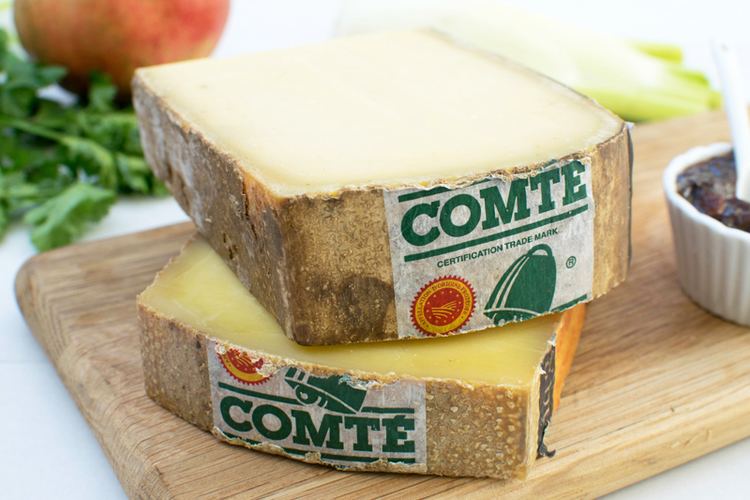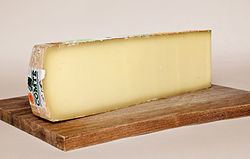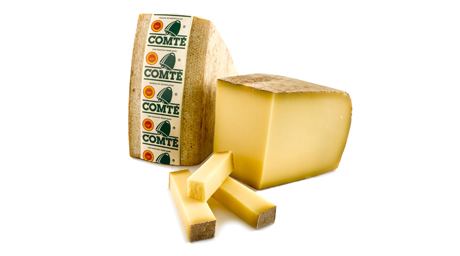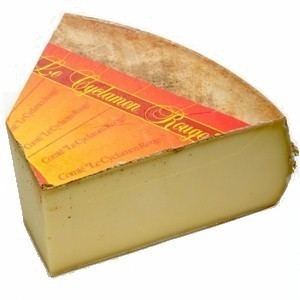Region, town Franche-Comté Pasteurised No Certification French AOC 1958 Rind Natural Aging 8-12 months | Source of milk Cows Aging time 8-36 months Milk source Dairy cattle Region of origin Franche-Comté Texture Semi-hard | |
 | ||
Similar Morbier cheese, Beaufort cheese, Reblochon, Roquefort, Camembert | ||
Comt cheesemonger series how to taste comt
Comté (or Gruyère de Comté) ([kɔ̃.te]) is a French cheese made from unpasteurized cow's milk in the Franche-Comté region of eastern France. Comté has the highest production of all French AOC cheeses, around 64,000 tonnes annually.
Contents

The cheese is made in flat circular discs, each between 40 cm (16 in) and 70 cm (28 in) in diameter, and around 10 cm (4 in) in height. Each disc weighs up to 50 kg (110 lb) with an FDM around 45%. The rind is usually a dusty-brown colour, and the internal pâte is a pale creamy yellow. The texture is relatively hard and flexible, and the taste is strong and slightly sweet.

Production

Fresh from the farm, milk is poured into large copper vats where it is gently warmed. Each cheese requires up to 600 litres (160 US gal) of milk. Rennet is added, causing the milk to coagulate. The curds are then cut into tiny white grains that are the size of rice or wheat which are then stirred before being heated again for around 30 minutes. The contents are then placed into moulds and the whey is pressed out. After several hours the mould is opened and left to mature in cellars, first for a few weeks at the dairy, and then over several months elsewhere.

The manufacture of Comté has been controlled by AOC regulations since it became one of the first cheeses to receive AOC recognition in 1958, with full regulations introduced in 1976. The AOC regulations for Comté prescribe:

In 2005 the French Government registered 175 producers and 188 affineurs (agers) in France.
Grading

Each cheese is awarded a score out of 20 by inspectors, according to 'overall appearance' (1 mark), 'quality of rind' (1.5), 'internal appearance' (3.5), 'texture' (5), and taste (9). Those scoring 15 or above are given a green casein label with the characteristic image of a green bell and may be called 'Comté extra', with 12-15 being given a brown label and simply called 'Comté'. Any cheese scoring under 3 marks for taste, or under 12 overall is prohibited from being named Comté and is sold for other purposes.
Jury Terroir
Comté is well-known for its distinct terroir, or distinct features such as smell and taste that it derives from the environment and traditional methods of its production. It is known for its distinctive taste that no two wheels of Comté taste alike. The diversity of tastes has several factors including: having been made in 160 village-based fruitières (cheese-making facilities) in their specific region, owned by farmers who bring their own milk from their cows; strict production rules linking between place and product; and the seasonal environmental effects. Because of its uniqueness and unfamiliarity, Comté cheeses go through the process of jury terroir, where panels of trained volunteer tasters from Comté supply chain and from the region discuss and publish bi-monthly in the newsletter Les Nouvelles de Comté about the taste and their results. This jury terroir was created by Florence Bérodier, the food scientist, to elaborate in response to a set of formidable challenges that Comté cheese underwent in the beginning for its unfamiliar taste and smell. “The Jury terroir is there to speak of all the richness in the tastes of a Comté…” - original member confirmed. For Comté cheese to be worldly renowned, the quality improved, but the challenge stand still to create a uniform taste, which was impossible to achieve since there were 160 different fruitières specializing. But through the process of jury terroir, people came to focus on communication among the tasters, which improved their ability to perceive and gained in value. They acquired a general culture that enabled to describe and exchange about the taste of Comtés.
